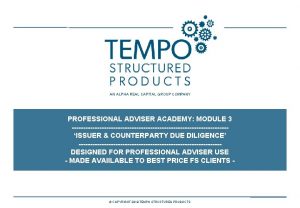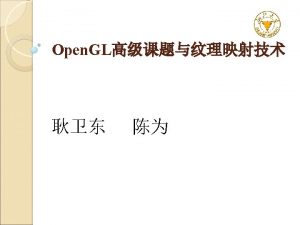AN ALPHA REAL CAPITAL GROUP COMPANY PROFESSIONAL ADVISER

























- Slides: 25

AN ALPHA REAL CAPITAL GROUP COMPANY PROFESSIONAL ADVISER ACADEMY: MODULE 2 ----------------------------------‘UNDERSTANDING STRUCTURED PRODUCTS’ -------------------------------DESIGNED FOR PROFESSIONAL ADVISER USE - MADE AVAIILABLE TO BEST PRICE FS CLIENTS - © COPYRIGHT 2018 TEMPO STRUCTURED PRODUCTS

Learning objectives of this Module … This Module aims to: § Highlight some of the factors currently characterising investment markets, and the ongoing challenges facing savers and investors § Provide a brief and simplistic look at how the UK retail structured product market has developed over the years and show the UK market compares to other regions globally § Explain some of the fundamental reasons why professional advisers and investors should consider including structured products in portfolios § Explain why the most important fact to understand about structured products is that they equate to ‘investing by contract’ … and to detail the benefits of this for investors § Explain what investment banks might (or might not) do when arranging / hedging structured products § Explain the different types of stock market protection that can be used in structured products § Introduce the basics of counterparty due diligence for professional advisers and to suggest pragmatic points regarding investor’s perspective of counterparty risk § Provide a case study to highlight how structured products can be developed to meet adviser and investor interests and requirements, in ways that other investment options cannot © COPYRIGHT 2018 ALPHA STRUCTURED PRODUCTS 2

Important notice: please take note of the legal disclaimer … This document is a financial promotion for the purposes of section 21 of the Financial Services and Markets Act 2000, issued by Tempo Structured Products and approved by TIME Investments. This document has been designed to is used by, FCA authorised persons, including financial advisory firms and ealth managers (‘professional advisers’). It has not been designed for retail clients. However, investor access is provided to it through Best Price FS, as a general service. No investment, legal, tax recommendation or advice of any type and no suggestion of suitability of any investment for any prospective investor is given or implied in this document. The information in this document does not take account of the investment objectives, particular needs or financial situation of any client or potential client of any professional adviser to whom this document is distributed. There are risks associated with an investment in any structured product. This document is for your information only and is not intended as an offer, or recommendation or solicitation of an offer to buy or sell any investment, security, financial instrument or other specific product, to conclude a transaction, or to provide any investment service or investment advice, or to provide any research, investment research or investment recommendation, in any jurisdiction. By accessing this document you will be taken to have represented, warranted and undertaken that: (i) you understand that this document is designed for professional adviser (as referred to above) use; (ii) that you have read, agree to and will comply with the contents of this notice; (iii) you will conduct your own analysis or other verification of the data set out in this document and will bear the responsibility for all or any costs incurred in doing so; and (iv) that you are not accessing and accepting this document from any jurisdiction other than the United Kingdom, in compliance with all laws and regulations applicable to such access and acceptance. This document and all information herein are provided “as is”, “as available” and no representation or warranty of any kind, express, implied or statutory, is made by regarding any statement or information herein or in conjunction with this document. Any opinions, market prices, estimates, forward looking statements, hypothetical statements, forecast returns or other opinions leading to financial conclusions herein reflect our subjective judgment as of the date of this document. Any forward looking information has been prepared on a number of assumptions which may prove to be incorrect and, accordingly, actual results may vary. Past performance is no guarantee of future results; nothing herein shall constitute any representation, warranty or prediction as to future performance of any issuer. Considerable care has been taken to ensure the information in this document is accurate, however no representation or warranty is given as to the accuracy or completeness of any information and no reliance may be placed for any purpose whatsoever on the information or opinions contained in this document or on its completeness and no liability whatsoever is accepted for any loss howsoever arising from any use of this document or its contents otherwise in connection therewith. 3

Important notice: don’t forget the risks Please note that this module does not constitute advice, nor is it a recommendation to invest in any plan. Investor access is provided to it through Best Price FS, as a general service. It should always be understood that: structured products are not suitable for everyone; past performance is not a reliable indicator of or guide to future performance and should not be relied upon, particularly in isolation; the value of investments and the income from them can go down as well as up; the value of structured products may be affected by the price of the underlying investments; capital is at risk and investors could lose some or all of their capital. Investors should always read the relevant plan documents relating to any structured product plan of interest, in particular: the plan brochure; plan application pack, including, the terms and conditions of the plan; and consider the issuer’s key information document (KID), securities prospectus and final terms sheet, for full details of any plan, including the features and information on the risks associated with an investment in the plan, before making a decision to invest in any plan. Investors should not invest in any investment product unless they understand it, in particular the relevant risks. This module was prepared in 2017. 4

Setting the scene. . . In 2008 an investor who had previously suffered substantial investment losses (of c£ 800 m) asked his wealth manager to ‘de-risk’ his remaining (£ 200 m) portfolio The mandate given to the wealth manager by the investor was ‘simple’: ‘‘Reduce my downside risk, limit my potential future portfolio losses, and retain strong participation in future upside growth potential’’ Some wealth managers would have told the investor what he wanted wasn’t possible … © COPYRIGHT 2018 ALPHA STRUCTURED PRODUCTS 5

The UK retail structured product sector’s journey … UK RETAIL STRUCTURED PRODUCTS: ANNUAL SALES (£BILLIONS) [DATA SOURCE: Structured. Retail. Products. com | Alpha Structured Products: to 31. 12. 16] 957 Products 57 Providers 16 14 12 10 8 6 4 191 Products 24 Providers 261 Products 38 Providers 308 Products 47 Providers 535 Products 56 Providers 610 Products 55 Providers 601 Products 55 Providers 696 Products 54 Providers 772 Products 57 Providers 915 Products 63 Providers 933 Products 45 Providers 990 Products 54 Providers 746 Products 47 Providers 555 Products 27 Providers 2 457 Products 16 Providers 338 Products 15 Providers 396 Products 13 Providers 2014 2015 2016 0 2000 § § 2001 2002 2003 2004 2005 2006 2007 2008 2009 2010 2011 2012 2013 Structured products were first seen in the UK in the mid 1990’s: with strong growth between 2000 - 2010: - the sector innovatively met many investor’s primary interests: growth in the market was demand led - a March 2011 Financial Times survey found 40% of investors (2000 surveyed) held a structured product However, some events and practices negatively impacted the sector through the noughties: 1999 - 2003: income products, that became known as precipice bonds, were poorly conceived and marketed 2008: the collapse of US investment bank Lehman Brothers highlighted counterparty risk Since 2009, the sector is smaller, for a number of reasons: but there are significant positives ----------------------------------------------------------------------The sector is fundamentally improved - and operates almost exclusively through professional advisers © COPYRIGHT 2018 ALPHA STRUCTURED PRODUCTS 7

The global retail structured products market … GLOBAL RETAIL STRUCTURED PRODUCTS: TOTAL MARKET VOLUME (£BILLIONS) [DATA SOURCE: Structured. Retail. Products. com | Alpha Structured Products: to 31. 12. 16] 700. 0 600. 0 500. 0 400. 0 300. 0 200. 0 100. 0 UK EUR US UK ASIA TRANCHE BASED PRODUCTS EUR US ASIA OPEN-END PRODUCTS UK EUR US ASIA TOTAL MARKET GLOBAL RETAIL STRUCTURED PRODUCTS: TOTAL MARKET VOLUME (£BILLIONS) UK EUROPE US ASIA GLOBAL TOTAL § TRANCHE PRODUCTS 16. 2 367. 4 185. 2 203. 7 772. 4 OPEN-END PRODUCTS 6. 3 87. 3 223. 0 423. 3 739. 9 TOTAL MARKET 22. 4 454. 7 408. 1 627 1, 512. 3 As can be seen, the UK is clearly behind other regions globally in the use of structured products: - one reason for this is that investment advice is more predominantly in the hands of wealth managers and independent advisers in the UK than in other regions (where banks tend to dominate) © COPYRIGHT 2018 ALPHA STRUCTURED PRODUCTS 8

Virtuous evolution: better calibre products / better calibre advice … § The UK retail sector has made fundamental improvements and advances in its approach in recent years, particularly post 2008 / 09 § Prescriptive regulatory rules and guidance have been a positive: § - it’s now exceptionally clear what is expected of structured product providers and professional advisers - (Module 13_’Understanding the regulations: rules, guidance and expectations’ provides a summary of the regulator’s reviews, actions and output regarding the structured products sector) The sector has also sought to advance best practice: - the UK Structured Products Association (UKSPA) has been helpful in coordinating the sector and advancing shared best practice amongst member firms The distribution dynamics of the market have also changed in the UK, with a shift from high street institutions selling products to captive customers to products now being designed for distribution through independent professional advisers, who select them on merit and suitability grounds for clients § An increasing number of advisers recognise the improvements across the sector, the efficacy of structured products and the value that carefully selected products can bring to an advice proposition: - but the merits of the sector and the value of its products warrant wider adviser recognition … © COPYRIGHT 2018 ALPHA STRUCTURED PRODUCTS 9

Why should advisers / investors consider structured products … § First and foremost, is the investment need: - particularly in the current investment environment, investors require value-adding investment options from the combined asset management / investment industries and providers - professional adviser consideration of ‘investment type’ (as well as asset class and geopgraphy), i. e. the best of active, passive / smart beta and structured products, may help improve portfolio diversification and balance Structured products offer investors options that neither active or passive funds can or do --------------------------------------------------------------------- Including many features that are pertinent / value-adding in the prevailing economic / market environment § Structured products can: - remove, reduce or at least define investor exposure to downside market risk, and the potential for loss of capital that is usually inextricably linked to stock market linked investments - provide the potential for defined returns, including the scope to generate positive returns without necessarily requiring the stock market to rise, and with some product options generating positive returns even if markets fall © COPYRIGHT 2018 ALPHA STRUCTURED PRODUCTS

The significant point of differentiation re structured products … § Secondly, there is a fundamental point of differentiation that stands structured products apart from other types of investments … § If you look under the bonnet of most types of investment, including actively managed mutual funds, you will find complicated ‘investment engines’: § - an investment / asset management company, with shareholders, executive management, etc. ; - layers of investment people and processes: fund managers, analysts, risk management, etc. - and a marketing department that sets out what the aims /‘hopes’ of the funds are for investors - but mutual funds can and do fail to deliver their stated aims / hopes; for a multitude and moving feast of reasons: - from macro economic events; to specific market events; down to simple basic lack of skill / error HOWEVER, If you look under the bonnet of a typical structured product you will find an empty engine bay, with ‘A CONTRACT’ sitting at the bottom instead of a complicated investment engine: STRUCTURED PRODUCTS EQUATE TO ‘INVESTING BY CONTRACT’ ------------------------------------------------------------- THIS IS A FUNDAMENTAL POINT OF DIFFERENTIATION VIS-À-VIS OTHER INVESTMENT OPTIONS AND IS PERHAPS THE SINGLE MOST IMPORTANT POINT FOR PROFESSIONAL ADVISERS TO UNDERSTAND © COPYRIGHT 2018 ALPHA STRUCTURED PRODUCTS

What’s so special about ‘investing by contract’ … § Structured products are typically based upon an investment bank (the counterparty) issuing securities or taking a deposit with pre-defined investment terms, i. e. levels and types of risk, conditions for returns, etc. § The securities are usually a type of bond (a debt instrument, such as Medium Term Note), that is listed on a recognised stock exchange: and all of the terms of the securities are contractual / legal obligations § Not only are all the terms and conditions of the investment set out as contractual / legal obligations, but fundamental risks usually inherent in investing can be addressed, i. e. : - exposure to both downside and upside market risk can be defined: i. e. the risk that markets fall and investors lose capital and / or the risk that markets don’t rise and positive returns may not be generated § Investing by contract transforms an investor’s exposure to investment ‘process and performance’ risk: § Investors effectively pass the process / performance risk that is normally inherent and unavoidable in investing in traditional investment funds to the product issuer / counterparty: § - whatever the issuer / counterparty does (or doesn’t do) during the terms of the investment, the contract dictates that the bank is legally obligated to deliver what was stated to investors (unless they are ‘bust’!) - this is fundamentally different to ‘traditional fund management’, where the risks of the fund manager’s process actually sit with investors: i. e. if a mutual fund process fails to deliver performance as per its aims / hopes, or if capital is lost because the market is down, and the process doesn’t protect against this, the fund manager will simply write to investors and politely explain why (whilst continuing to take all of their charges!) Investing by contract is a highly compelling USP and investment proposition for investors © COPYRIGHT 2018 ALPHA STRUCTURED PRODUCTS 12

Sounds neat: but there must be ‘some clever stuff’ going on … § Okay, so the most important point about structured products is that they are based upon contracts – but counterparty banks must be ‘doing some clever stuff’, in the process of arranging products? § This is true - although the clever stuff is actually quite straightforward to understand: - § but the pertinent fact and point to understand is that what counterparty banks may (or may not) do behind the scenes is done in order to hedge themselves in respect of their legal obligations to precisely deliver what is contractually required by the terms of their product’s securities, at maturity Investors in structured products are NOT investing directly into the process of what the counterparty bank may (or may not) do: - investors are investing in the contract that details the terms of the product / plan: and are taking on the risk that the counterparty issuing the contract will be solvent at maturity: i. e. the ‘counterparty credit risk’ - whether the bank does everything right or anything / everything wrong in the process, if the bank is solvent at maturity - which is always the fundamental belief / expectation - investors will get precisely what was detailed We will come on to what a counterparty bank may or may not do when arranging structured products ------------------------------------------------------------------------But it is essential for advisers and investors to understand that the ‘process risk’ of what a bank may (or may not) do is a risk for the bank, not investors: assuming the bank is solvent at maturity (although investors who may seek to exit from products before maturity need to understand that the ‘secondary market prices’ of structured products are affected by various factors during the investment term) © COPYRIGHT 2018 ALPHA STRUCTURED PRODUCTS 13

Ramming home the ‘contract point’ of structured products … § - Let’s prove this contract point - and make it absolutely easy to understand: in the process, let’s also deal with a ‘faction’ re structured products, which is the suggestion that they are ‘complex’ products: this comment is usually made with regard to the use of derivatives, and it’s been said so often that it’s become accepted as a reverberating point - as a ‘fact’: but this is misguided / poorly understood … - firstly, fundamentally, there is nothing wrong with derivatives (they, themselves, are simply contracts) - secondly, as is being explained, investors in structured products are NOT investing directly into the process of products or into derivatives: even if the counterparty bank may use them in their arrangements / hedging process § Proving structured products equate to investing by contract - and that the derivatives point is a red herring: - imagine that on the first day of a 5 -year structured product the treasury team of the counterparty bank goes on holiday: and no ‘zero coupon bond’ is put in place. Nothing! Nada! Rien! - imagine also, that on the same day, the equity derivatives team of the counterparty bank goes on the same holiday: and no derivatives are arranged. Nothing! Nada! Rien! - and, just for good measure, the risk management of the bank is also on the holiday: and is not there to check that the treasury team and equity derivatives team are at work: precisely nothing is therefore done, by anybody. - (alternatively, imagine the opposite: the bank does everything it could … but royally messes it all up!) QUESTION: what can investors expect from the structured product, when it matures? ANSWER: everything they were told to expect, at the outset … because the investment is ‘defined by contract’ © COPYRIGHT 2018 ALPHA STRUCTURED PRODUCTS 14

Why do investment banks issue structured products … § So, why do investment banks issue structured products: what’s in it for them? - the answer is straightforward: investment banks use structured products as a method of raising funds, in much the same way that they might issue corporate bonds on the money markets or aim to attract deposits from retail or corporate customers (if they have retail banking / deposit taking operations); - more specifically, the treasury teams of the investment banks try to use structured products as a more cost effective (i. e. cheaper) means of raising funds than issuing corporate bonds © COPYRIGHT 2018 ALPHA STRUCTURED PRODUCTS 15

So, what might a bank do when arranging a structured product … § So, what might an investment bank do, behind the scenes, when arranging a structured product? - actually, what the banks typically do when arranging a product, or ‘hedging’ themselves against the legal obligation to deliver the terms of the product at maturity, is straightforward: - FIRSTLY: the treasury team of the bank may arrange something known as a ‘Zero Coupon Bond’: this may sound like a technical term, but basically it’s just an internal deposit, with no (i. e. ‘zero’) interest being paid - … and, generally speaking, most savers and investors understand the principles of bank deposits - SECONDLY: the equity derivatives team of the bank may arrange some derivatives (noting that derivatives themselves are actually nothing more than contracts between two parties: and retail structured products generally involve very ‘plain vanilla’ types of derivative contracts): - for example, ‘call options’ (may be bought for upside) and / or ‘put options’ (may be sold to increase potential upside or provide enhanced levels of income) - THIRDLY: there will usually be charges that have been built into / taken out of the product (although the returns of structured products are normally stated after allowing for any charges) We will now take a look at this in more detail: remembering that whilst the process may be of interest what a counterparty may or may not do behind the scenes of a structured product is basically irrelevant, if the counterparty bank is solvent throughout the investment term and the product is held to maturity … © COPYRIGHT 2018 ALPHA STRUCTURED PRODUCTS 16

A simplified run through of the mechanics of a structured product … View as a slide show for best presentation ced odu intr en s be ha ital + 15% 3% 7% Put options (may be sold, to generate a premium of, say, 15%) Internal charges mar ris ket al apit m no e is ther o c sk t i r t arke (may be bought) tere Zero coupon bond (basically a deposit that doesn’t distribute interest during its term) STRIKE DATE + Y% Growth or income is generated (with no market risk to capital) + X% At maturity, the value of the zero coupon bond has been calculated so that it will be worth 100% of the initial capital invested by investors 100% ate l umu cc st a (because the structure now includes market risk to capital) term the g n i r s du Call options in 90% cap k to Additional levels of growth or income can be targeted (if the counterparty is solvent) COUNTERPARTY RISK MATURITY DATE [PLEASE NOTE: This page can be viewed as a slide show, for best presentation effect. It should also be understood that this is a simplified version of the basic principles of what a bank may do when arranging / hedging a structured product. Different products may involve differing processes. ] 17

A closer look at what a bank may do to arrange / hedge a product … View as a slide show for best presentation FIRSTLY, THE TREASURY TEAM OF THE BANK MAY USE ABOUT 90% OF THE FUNDS THEY RECEIVE TO CREATE A ‘ZERO COUPON BOND’, WHICH IS DONE IN ORDER TO HEDGE THE REPAYMENT OF THE INITIAL CAPITAL AT THE MATURITY DATE. PRODUCT OFFER PERIOD (typically c 4 -8 weeks) £ 10 M IS RAISED THE PLAN MANAGER / ADMINISTRATOR SENDS THE FUNDS TO THE ISSUING BANK / COUNTERPARTY, ON THE ‘STRIKE’ (I. E. START) DATE OF THE INVESTMENT TERM THE COUNTERPARTY IS LEGALLY OBLIGATED, BY CONTRACT, TO DELIVER THE RETURNS OF THE PRODUCT: BUT WHAT MIGHT THE BANK DO TO ARRANGE THE PRODUCT (AND HEDGE THEIR POSITION), BEHIND THE SCENES CAPITAL REPAYMENT COUNTERPARTY / CREDIT RISK (& FUNDING) AAA ZERO COUPON BOND (Internal Deposit) £ 9 m 6 YR INT. RATE SWAP AA AA A-A- EXAMPLE HSBC Barclays BBB+ Deutsche BBB Investec LIBOR FLAT - LIBOR + 50 bp’s -3% - 3% LIBOR + 150 bp’s -9% - 9% Establishment Costs (at maturity) GROWTH | INCOME ‘PROTECTED’ GROWTH The bank may buy call options to participate in index growth ‘Ca. R’ GROWTH The bank may buy call options but LIBOR + 250 bp‘s -15% - 15% LIBOR + 250 bp’s also sell put options (which introduces LIBOR + ? ? ? Ca. R) to generate a premium - that can be used to buy more call options IMPLICIT CHARGES BUILT IN (3%) £ 10 m SECONDLY, THE EQUITY DERIVATIVES TEAM OF THE BANK MAY USE ABOUT 7% OF THE FUNDS AND ARRANGE TO BUY CALL OPTIONS, (WHILE ALSO SELLING PUT OPTIONS, IN ORDER TO FUND ADDITIONAL CALL OPTIONS), IN ORDER TO HEDGE THE FIXED OR POTENTIAL GROWTH OR INCOME RETURNS OF THE PRODUCT Administration + Custody Costs Provider Margin / Profit Plan Manager Profit ‘Ca. R’ INCOME The bank may simply sell put options, and use the premium, with the balance of the ZCB, to fund the income payments [PLEASE NOTE: This page can be viewed as a slide show, for best presentation effect. It should be understood that this is a simplified version of the basic principles of what a bank may do when arranging / hedging a structured product. Different products may involve differing processes. The pricing used, including funding levels, is for indicative / illustrative example purposes only. ] 18

Different types of put options and protection ‘barriers’ … § For structured products that are ‘capital-at-risk’ there are different types of put option, that create different types of protection barrier - and it is possible to set the level of protection, whichever type of put option / barrier is used: - it is important for professional advisers to understand the different types and levels, not only from an investor / investment perspective, but also from a manufacturing / pricing perspective TYPES OF PUT OPTION / PROTECTION BARRIER ‘AMERICAN’ BARRIERS Monitored continuously (using intra-day prices) - can be breached at any point - intra-day movement can be +/- 10% - introduces greatest risk - not transparent - therefore generates the highest premium for the put, so higher headline rate products are possible (but not necessarily sensible) HIGHER Monitored continuously (using daily closing prices) - can be breached at any point - excludes intra-day movement - reduces risk - and offers better transparency ‘EUROPEAN’ BARRIERS Monitored at maturity only - cannot be breached during the term (the index is not even monitored) - clearly reduces / transforms risk - and very easy to understand - therefore generates less premium - therefore generates the least premium for the put, so lower rate products are for the put, so leads to slightly lower inevitable: but risk has been transformed headline rate products (but which may be more sensible) POTENTIAL INVESTOR RISK © COPYRIGHT 2018 ALPHA STRUCTURED PRODUCTS (which may often be eminently sensible) LOWER 18

Counterparty due diligence … § Structured products are based upon contracts, that depend upon the solvency of the institution that stands behind the contract, i. e. the counterparty bank § Counterparty due diligence needs to be undertaken by professional advisers to assess the risk: - Credit ratings: are the leading indicator of an institution’s financial strength / credit risk (ratings agencies tend to be long term focused and can be slow to react to events) - Credit Default Swaps (CDS): provide a complementary and independent tool / measure of credit risk (the CDS market can be more short term, and very swift to react to events) - ‘Fundamentals’: such as the balance sheet, should also be generally considered (including factors such as ultimate parent, systemically important retail bank / deposit holder, country of domicile, etc. ) Counterparty HSBC Bank Barclays Deutsche Bank Investec Bank S&P AAABBB+ - Credit Ratings Moody’s Aa 2 A 3 A 2 Fitch AAA ABBB 1 -Year CDS 5 -Year CDS Tier 1 29. 98 44 168. 38 - 75. 4 93. 21 219. 21 (228 imp) 11. 8 14. 70 14. 7 10. 7 [DATA: Bloomberg 25. 11. 16] [See Module 4_’Counterparty Due Diligence’ for a detailed overview of counterparty due diligence considerations for professional advisers] © COPYRIGHT 2018 ALPHA STRUCTURED PRODUCTS 20

Counterparty considerations for advisers: and investors … § Given the importance of counterparties, can professional advisers / investors be expected to be capable of assessing the credit risk / financial strength of a bank and whether it is likely to remain in business? § Advisers are certainly not expected to become credit experts - but they should be aware of some of the basic / fundamental points pertinent to considering ‘financial / credit strength’, such as credit ratings § It is important to understand that issuer / counterparty risk is a performance issue: and the FCA does not regulate performance, per se: § - but the risks and consequences of any / all risks must be detailed, in a clear, fair and not misleading manner - and client’s tolerances for risk must be identified and suitable investments selected It is also pragmatic to suggest that investors can understand ‘counterparty risk’, at least in general terms: - for example, savers / investors generally know and understand that if they place their deposit with a big bank, that doesn’t want or need their funds, they may get a low rate of interest; but if they want or need a higher rate of interest and they deposit with a smaller bank, that wants their funds more, they can get a higher rate … and that’s all about counterparty credit risk: so it’s not so tricky to understand the principles - and many savers and investors may also remember - or can / should be reminded about - Icelandic banks, Northern Rock, etc. : and some may have heard of Lehman Brothers (or can be reminded of the events) The fact is that structured products can remove or reduce market risk, provide pre-defined returns and do it all by contract … but they present issuer / counterparty risk, which needs to be understood © COPYRIGHT 2018 ALPHA STRUCTURED PRODUCTS 21

Returning to the introduction: a case study … In 2008, an investor who had lost £ 800 m in 2003 (when the TMT bubble burst) asked his adviser to ‘de-risk’ his remaining £ 200 m portfolio. More specifically, the investor asked that portfolio risk be reduced, potential future losses be limited, whilst strong participation in future growth be retained … § The process started by designing a product with a portfolio that replicated the adviser’s global equity asset allocation model, using indices § The next step was to focus on risk control: the downside risk was changed to a ratio of 1: 4 § - meaning that the client only suffered 1/4 of any downside: i. e. only 1% lost for any 4% fall in the portfolio - notably, the maximum loss was therefore 25%: which was only possible if each and every index went to zero! Then came the focus on growth: upside participation was changed to a ratio of 7: 1 (i. e. 700% participation) - meaning the client enjoyed a 7% gain for any 1% rise in the portfolio, capped at 70% - a 10% gain on the portfolio would therefore generate a 70% investor return - above 70%, 100% participation in unlimited portfolio growth was also built in § Investment timing was a concern in Q 1 2008: so ‘phased entry’ was used, from March ‘ 08 to March ’ 09 § Daily liquidity was included § The Plan had no explicit fees (with internal fees less openly agreed|: at less than 35 bp’s pa) The Plan not only met but surpassed the wealth manager’s expectations -------------------------------------------------… AND the client’s (AND the top 4 accountancy firm that was involved) © COPYRIGHT 2018 ALPHA STRUCTURED PRODUCTS 22

Sounds great: how did it perform … The Plan added significant value over and above the wealth manager’s asset allocation model AND the benchmark: transforming the risk / return profile The wealth manager’s own global equity asset allocation model The relevant benchmark for the investor was the MSCI World Index © COPYRIGHT 2018 ALPHA STRUCTURED PRODUCTS 23

In conclusion … § § Structured products can ‘bend or break’ the relationship between market risk and return and investor’s risk and returns, in ways that active and passive funds simply don’t and can’t. This includes: - removal, reduction or at least defined exposure to market downside risk - and fixed / non conditional returns, and returns that can be generated even in range bound or falling markets Structured products effectively exchange risks that are usually inextricable in other types of investment, most notably market risk, for counterparty risk: - § Investing by contract is a major benefit of structured products: § the risk basically becomes whether the major investment bank, that’s likely to be one of the strongest financial institutions in the world, stays in business and meets all of its obligations throughout the investment term no other type of investment places legal / contractual obligations on the provider regarding investment outcomes, removing investor exposure to process / performance risk, as structured products do Especially in the current investment environment, ‘best of breed’ structured products can add value in genuinely diversified portfolios – helping diversify investment type as well as asset class / geography Understanding the background to the structured products sector, how structured products work and when and how to use them, is key to meeting investor’s interests and requirements -------------------------------------------------------------------Relatively simplistic, general working knowledge of structured products is sufficient to illuminate the fact that they are straightforward and transparent products to understand - for advisers and investors: … arguably more so than many other types of investment © COPYRIGHT 2018 ALPHA STRUCTURED PRODUCTS 24

Learning outcomes of this Module … Following completion of Module 2, you should now … § Be aware of some aspects of the current market environment and the challenges presented by low interest rates, low bond yields and uncertain equity markets for investors § Understand that the UK retail structured products market has evolved significantly over the years, that it is currently smaller, tightly regulated and almost exclusively accessed by investors through professional advisers. § Understand that structured products equate to ‘investing by contract’ and recognise how this differentiates structured products from other types of investment - and that investors seeking to diversify and balance their portfolios should diversify the types of investment that they hold as well as asset class and geography § Understand why investment banks issue structured products § Understand the basics of how a structured product may be arranged / hedged by an investment bank, in terms of the knowing that the process may include a zero coupon bond and call and put options but understanding that the most important point is that a counterparty is legally obligated to deliver the stated terms of a product at maturity, if they are solvent, regardless of what they may (or may not) have done. § Understand the different types of stock market risk protection ‘barriers’, and when and how these may affect whether an investor’s capital is at risk § Understand counterparty risk and have a high level idea of the ways to assess it If you would like to test your knowledge, please access the online Module test … © COPYRIGHT 2018 ALPHA STRUCTURED PRODUCTS 25

Tempo Structured Products is a trading name of ARCSP LLP, registered in England under number OC 400846, with its registered offices at 338 Euston Road, London NW 1 3 BG. Tempo Structured Products is an appointed representative of TIME Investments, which is a trading name of Alpha Real Property Investment Advisers LLP. Alpha Real Property Investment Advisers is authorised and regulated by the Financial Conduct Authority, 25 The North Colonnade, Canary Wharf, London E 14 5 HS, under FCA No. 534723. Tempo Structured Products and TIME Investments are subsidiaries of Alpha Real Capital LLP, which is authorised and regulated by the Financial Conduct Authority, under FCA No. 436048. © COPYRIGHT 2018 TEMPO STRUCTURED PRODUCTS 26
 Zeta phi beta pledge club
Zeta phi beta pledge club Alpha 1 vs alpha 2 receptors
Alpha 1 vs alpha 2 receptors Alpha kappa alpha membership intake process manual
Alpha kappa alpha membership intake process manual What fraternity was founded in 1906
What fraternity was founded in 1906 Aka graduate information session
Aka graduate information session Invitation alpha kappa alpha mip timeline
Invitation alpha kappa alpha mip timeline Alpha phi alpha
Alpha phi alpha Pi eta omega
Pi eta omega Alpha omega alpha osteopathic
Alpha omega alpha osteopathic Alpha kappa alpha slides
Alpha kappa alpha slides Manuel roxas economic policies
Manuel roxas economic policies Ucas advisers
Ucas advisers Ceri evans bournemouth
Ceri evans bournemouth Mlc adviser guide
Mlc adviser guide Certified crop adviser certification
Certified crop adviser certification Office of the worker adviser
Office of the worker adviser Condo adviser
Condo adviser Temporosis
Temporosis Professional capital definition
Professional capital definition Net working capital refers to which of the following
Net working capital refers to which of the following Difference between capital reserve and reserve capital
Difference between capital reserve and reserve capital Multinational cost of capital and capital structure
Multinational cost of capital and capital structure Difference between capital reserve and reserve capital
Difference between capital reserve and reserve capital Regulatory capital vs economic capital
Regulatory capital vs economic capital Regulatory capital vs economic capital
Regulatory capital vs economic capital Constant capital and variable capital
Constant capital and variable capital

















































